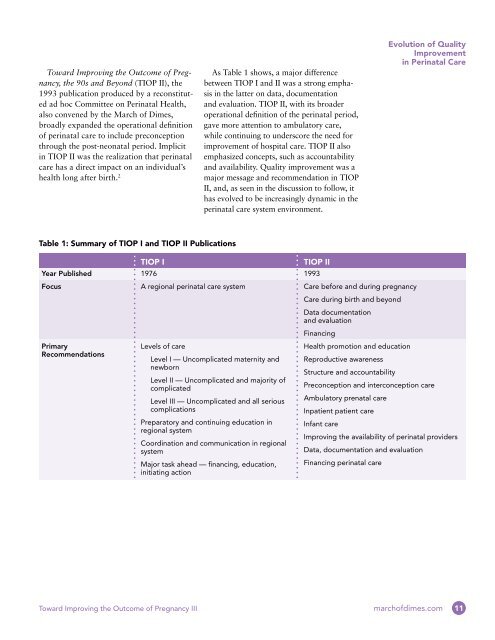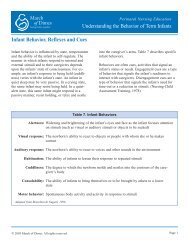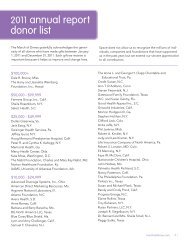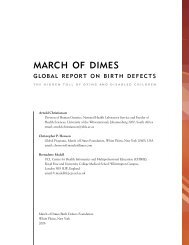Toward Improving the Outcome of Pregnancy III - March of Dimes
Toward Improving the Outcome of Pregnancy III - March of Dimes
Toward Improving the Outcome of Pregnancy III - March of Dimes
Create successful ePaper yourself
Turn your PDF publications into a flip-book with our unique Google optimized e-Paper software.
<strong>Toward</strong> <strong>Improving</strong> <strong>the</strong> <strong>Outcome</strong> <strong>of</strong> <strong>Pregnancy</strong>,<br />
<strong>the</strong> 90s and Beyond (TIOP II), <strong>the</strong><br />
1993 publication produced by a reconstituted<br />
ad hoc Committee on Perinatal Health,<br />
also convened by <strong>the</strong> <strong>March</strong> <strong>of</strong> <strong>Dimes</strong>,<br />
broadly expanded <strong>the</strong> operational definition<br />
<strong>of</strong> perinatal care to include preconception<br />
through <strong>the</strong> post-neonatal period. Implicit<br />
in TIOP II was <strong>the</strong> realization that perinatal<br />
care has a direct impact on an individual’s<br />
health long after birth. 2<br />
Table 1: Summary <strong>of</strong> TIOP I and TIOP II Publications<br />
Year Published<br />
Focus<br />
Primary<br />
Recommendations<br />
TIOP I<br />
1976<br />
A regional perinatal care system<br />
Levels <strong>of</strong> care<br />
As Table 1 shows, a major difference<br />
between TIOP I and II was a strong emphasis<br />
in <strong>the</strong> latter on data, documentation<br />
and evaluation. TIOP II, with its broader<br />
operational definition <strong>of</strong> <strong>the</strong> perinatal period,<br />
gave more attention to ambulatory care,<br />
while continuing to underscore <strong>the</strong> need for<br />
improvement <strong>of</strong> hospital care. TIOP II also<br />
emphasized concepts, such as accountability<br />
and availability. Quality improvement was a<br />
major message and recommendation in TIOP<br />
II, and, as seen in <strong>the</strong> discussion to follow, it<br />
has evolved to be increasingly dynamic in <strong>the</strong><br />
perinatal care system environment.<br />
Level I — Uncomplicated maternity and<br />
newborn<br />
Level II — Uncomplicated and majority <strong>of</strong><br />
complicated<br />
Level <strong>III</strong> — Uncomplicated and all serious<br />
complications<br />
Preparatory and continuing education in<br />
regional system<br />
Coordination and communication in regional<br />
system<br />
Major task ahead — financing, education,<br />
initiating action<br />
Evolution <strong>of</strong> Quality<br />
Improvement<br />
in Perinatal Care<br />
TIOP II<br />
1993<br />
Care before and during pregnancy<br />
Care during birth and beyond<br />
Data documentation<br />
and evaluation<br />
Financing<br />
Health promotion and education<br />
Reproductive awareness<br />
Structure and accountability<br />
Preconception and interconception care<br />
Ambulatory prenatal care<br />
Inpatient patient care<br />
Infant care<br />
<strong>Improving</strong> <strong>the</strong> availability <strong>of</strong> perinatal providers<br />
Data, documentation and evaluation<br />
Financing perinatal care<br />
<strong>Toward</strong> <strong>Improving</strong> <strong>the</strong> <strong>Outcome</strong> <strong>of</strong> <strong>Pregnancy</strong> <strong>III</strong> march<strong>of</strong>dimes.com<br />
11

















